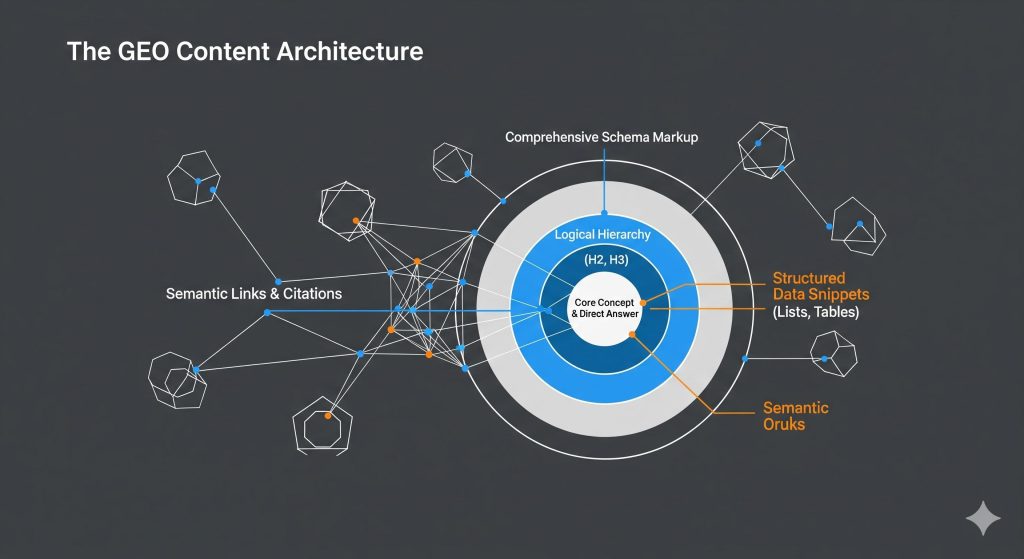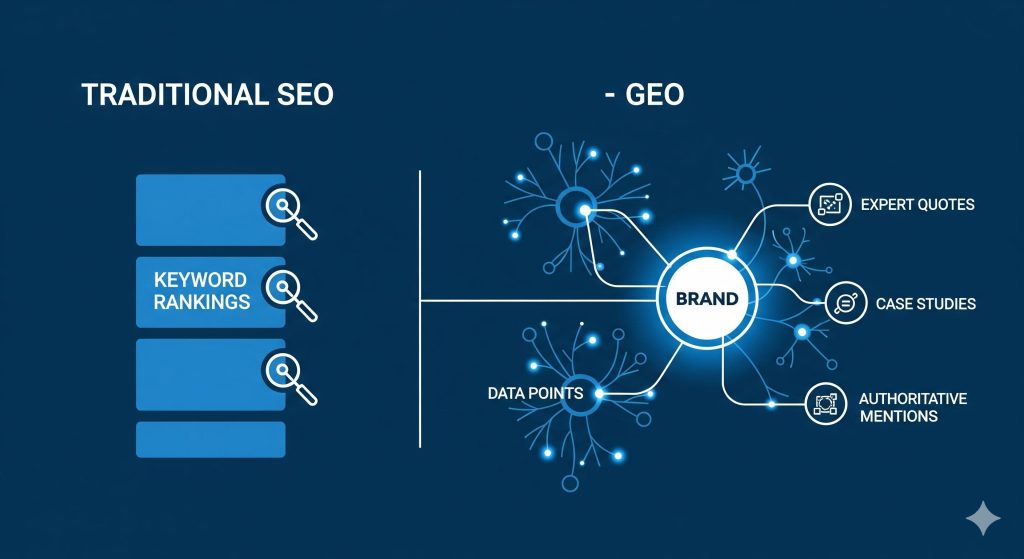A new paradigm for digital visibility
The ground beneath digital marketing is shifting. For two decades, search engine optimization (SEO) has been the undisputed king of visibility, a complex dance of keywords, backlinks, and technical wizardry. But the rise of generative AI and its integration into search engines like Google’s AI Overviews and platforms like Perplexity and ChatGPT has birthed a new discipline: generative engine optimization (GEO). This is not an iteration of SEO; it is a fundamental rethinking of how we create and structure information for a world where the search engine provides the answer, not just the links.

Traditional SEO targets rankings. GEO targets inclusion. The goal is no longer simply to be at the top of a list of blue links but to be the source material for the AI-generated answer itself. This requires a strategic pivot, moving away from merely satisfying algorithms to directly informing language models. This checklist provides a comprehensive framework for navigating this new terrain in 2025, grounded in the principles that govern how AI discovers, trusts, and synthesizes information.
Foundational shift: from keywords to concepts
The era of obsessing over exact-match keywords is over. Generative engines operate on concepts, entities, and the semantic relationships between them. Your content strategy must evolve from a keyword-centric model to a topic-centric one, building a dense web of interconnected, authoritative information.
Develop a comprehensive topic ontology. Instead of a list of keywords, map out the entire universe of a subject relevant to your expertise. Identify the core concepts, related entities, and the questions that connect them. Think like an encyclopedia, with each piece of content being a detailed entry that links to others.
Prioritize long-tail conversational queries. The way users interact with generative AI is conversational. They ask full questions. Your content should be structured to directly answer these questions. Use tools to identify the specific, nuanced questions your audience is asking and build content that provides definitive, comprehensive answers.
Focus on semantic richness. Incorporate synonyms, related terms, and contextual language throughout your content. This helps language models understand the depth of your knowledge and the relationships between different concepts. Avoid jargon where simpler language suffices, but use precise, domain-specific terminology where it enhances clarity and demonstrates expertise. Research has shown that using domain-specific jargon can improve visibility in AI-generated results by as much as 21%.
Content architecture for AI consumption
Generative engines are voracious consumers of information, but they are also lazy. They prefer content that is easy to parse, structured logically, and formatted for extraction. Your content must be architected for both human readability and machine comprehension.
Structure content with a clear hierarchy. Use H1, H2, and H3 tags logically to create a clear informational structure. This isn’t just for aesthetics; it’s a roadmap for AI crawlers to understand the relationships between different sections of your content.
Front-load the answer. Start every piece of content with a concise summary that directly answers the primary question. This “executive summary” is prime real estate for AI extraction.
Use lists, tables, and structured formats. Bullet points, numbered lists, and tables are easily digestible for AI. They break down complex information into discrete, extractable chunks.
Implement comprehensive schema markup. Go beyond basic schema. Use
FAQPage,HowTo,Article, and other relevant schema types to explicitly tell generative engines what your content is and how it’s structured. This removes ambiguity and makes your content more attractive for inclusion in rich results and AI-generated answers.
The new authority: E-E-A-T and beyond
In the age of AI, trust is the most valuable currency. Google’s E-E-A-T (Experience, Expertise, Authoritativeness, and Trustworthiness) guidelines are no longer just a best practice for SEO; they are the bedrock of GEO. Generative engines are explicitly designed to surface information from sources they deem credible.
Embed expertise directly into your content. Include author bios that highlight relevant credentials and experience. More importantly, embed expert quotes and attribute them clearly. Studies have shown that embedding expert quotes can increase inclusion in AI-generated results by a staggering 41%.
Cite your sources meticulously. Link out to authoritative studies, data sources, and academic papers. This demonstrates a commitment to accuracy and allows the AI to verify the information you’re presenting. Inline citations have been shown to boost visibility by 30%.
Show your work with data. Make specific, quantifiable claims and back them up with data. Vague statements are ignored; concrete statistics are cited. A claim like “our software is used by over 15,000 businesses in 50 countries” is far more powerful than “many businesses use our software.”
Cultivate brand mentions and co-citations. Generative engines don’t just look at links; they look at the company you keep. Being mentioned alongside established authorities in your field builds your credibility. Actively seek out opportunities for your brand to be featured in industry roundups, reports, and expert commentaries.
The contrarian view: is GEO just a distribution game?
A dissenting perspective argues that GEO is less about technical optimization and more about sheer distribution. In this view, the entities with the most extensive media footprints—those who can get their content and brand mentioned across the widest array of platforms—will win, regardless of their schema markup or content structure. This perspective suggests that the current large language models, in their quest for broad information, are biased towards sources that are simply ubiquitous.
While there is an element of truth to this—a wider distribution network is undeniably powerful—it oversimplifies the mechanics of generative AI. These models are not just looking for any information; they are looking for reliable, verifiable information. A brand with massive distribution that consistently puts out low-quality, untrustworthy content will eventually be down-weighted by the algorithms.
The optimal strategy lies in a hybrid approach: building a robust distribution network while ensuring that the content being distributed is of the highest quality and structured for AI consumption.

Measuring what matters: the new KPIs of GEO
The metrics that defined success in traditional SEO are insufficient for measuring GEO. Clicks and rankings are becoming less important than visibility and influence within the AI-generated answer itself.
AI citations and brand mentions. Track how often your brand or content is cited as a source in AI-generated responses to relevant queries. This is the new “ranking.”
Share of voice in AI answers. For a given set of queries, what percentage of the AI-generated answers mention your brand versus your competitors?
Sentiment analysis. How is your brand being portrayed in AI-generated answers? Is the sentiment positive, neutral, or negative?
LLM referral traffic. While direct clicks may be declining, traffic from users who are prompted to visit your site after an AI interaction is a key indicator of success. A study from the Pew Research Center found that users are less likely to click on traditional links when an AI summary is present, making the traffic that does come through even more valuable.
A suite of new tools is emerging to track these GEO-specific KPIs, including platforms that monitor your brand’s presence across different large language models and analyze the sentiment of those mentions.
The risks and realities of a generative future
Optimizing for generative engines is not without its challenges. The algorithms are a “black box,” with less transparency than traditional search ranking factors. There’s also the risk of “content saturation,” where a flood of AI-optimized content creates a homogenous information landscape, diminishing the value of unique insights.
Furthermore, there is a legitimate concern about the decline of organic traffic. As generative engines provide more comprehensive answers directly on the results page, the need for users to click through to individual websites may decrease. Some publishers have already reported significant drops in traffic from search engines.
However, the traffic that does come through is likely to be more qualified. A user who has already received a summary of information from an AI and still chooses to click through to your website is demonstrating a higher level of intent.
The future of digital visibility is not a zero-sum game between SEO and GEO. It’s an integration. A strong SEO foundation—a technically sound website, a good user experience, and high-quality content—is still essential. GEO builds upon that foundation, adapting it for a new era of information consumption. The brands that will thrive in 2025 and beyond are those that understand this new paradigm and build their content strategies not just to be found, but to be known.

